28th annual FACE Fall Scholarship Dinner raises more than $300,000
WESTPORT — On Wednes day, November 2, more than 400 friends, supporters, Catholic school students, faculty and staff attended an inspirational evening in support of FACE at White’s of Westport.
A dedicated Fall Scholarship Dinner Committee led by John Feitelberg, President of HUB International, and Janna Lafrance, of Lafrance Hospitality, worked together to help raise more than $300,000 in support of FACE stu dent scholarships.
The night began with a welcome from Emcee Kait Walsh, WPRI anchor and Bishop Stang Alumna ’08. Kait extended special thanks to Presenting Sponsors: BayCoast Bank and its subsidiaries, BayCoast Mortgage, Partners Insurance and Plimoth Investment Advisors; The Carney Family Charitable; and Rockland Trust Charitable Foundation.
Bishop Edgar M. da Cunha, S.D.V., presented the Timothy J. Cotter Friend of Catholic
Diocese of Fall River to hold collection to aid Catholic aging religious


FALL RIVER — The National Religious Re tirement Office (NRRO) announced that on De cember 10-11, the Diocese of Fall River will hold the annual Retirement Fund for Religious collection in parishes throughout the diocese.


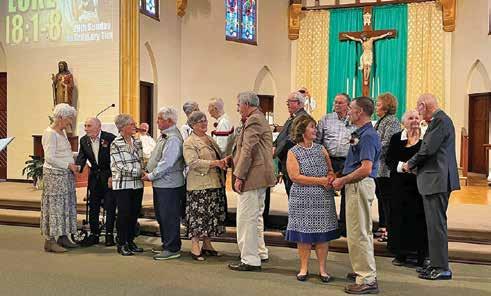
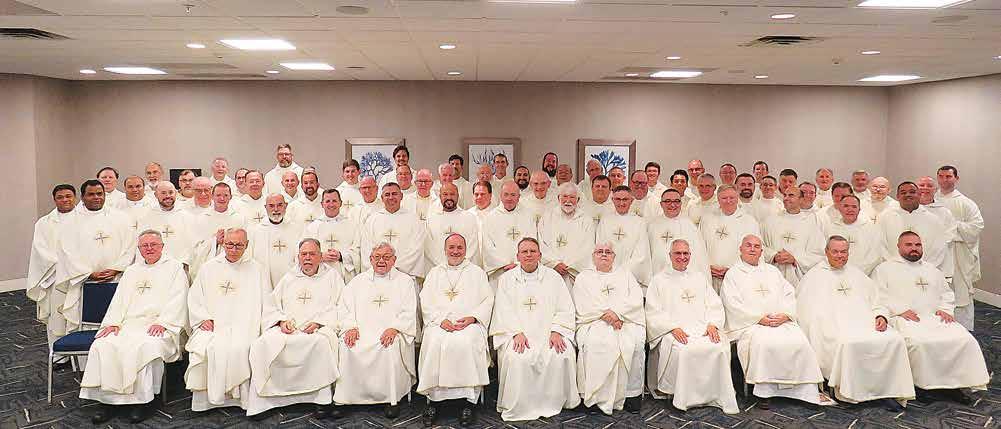

Last year, the pa rishioners in the diocese donated $93,326.67 to the
collection. About the up coming collection, NRRO Executive Director Sister Stephanie Still, a member of the Sisters of the Pre sentation of San Francis co, said, “The care of our aging religious presents an enormous financial re sponsibility. It is our priv ilege to care for those who gave a lifetime of tireless service, and I feel we are
deeply blessed by all the U.S. Catholic donors who have steadfastly contribut ed to this fund.”
Historically, Catho lic Sisters, Brothers, and religious order priests— known collectively as women and men religious — served for little to no pay. With rising healthcare expenses, hundreds
November 11, 2022 1
page three
8 Turn to page seven 8 Turn to
Couples renew their vows during the St. Joseph Church’s Golden Jubilee celebration on October 15 in Fairhaven. (Story on page two. Photo by Carol Renaux)
Diocesan priests gathered with Bishop Edgar M. da Cunha, S.D.V., during the annual Presbyteral Convocation for formation, personal spiritual development, business topics, fraternity, prayer and fellowship. This year’s event was held from October 25-27 at Four Points by Sheraton in Eastham.
Fairhaven parish celebrates married couples, religious
FAIRHAVEN — St. Joseph Church recently honored couples who have been married for 50 years or more, and mem bers of religious orders who have served for 50 or more years. Ten couples and five religious were honored at a celebration


on October 15.
The Golden Jubilee celebration included a special thanksgiving Mass, the couples renew ing their vows, a dinner, and a chance for family members to say a few words about those being recognized.
“Jubilee is a time to sit back, relax and reflect on the journey of life and to express our gratitude to God for everything,” wrote Father Stephen Banjare, SSCC, pastor of St. Joseph, in an email. “It is a time of celebration. Our common vocation is
a call to holiness which each of us respond and live differently — some as a married couple and some as single consecrat ed. During the jubilee, in gratitude, we celebrate the courage to respond to this call, our commitment and fidelity to this vocation and our perseverance.”
At the dinner, a vid eo presentation honored each jubilarian, and all were invited to dance the night away.
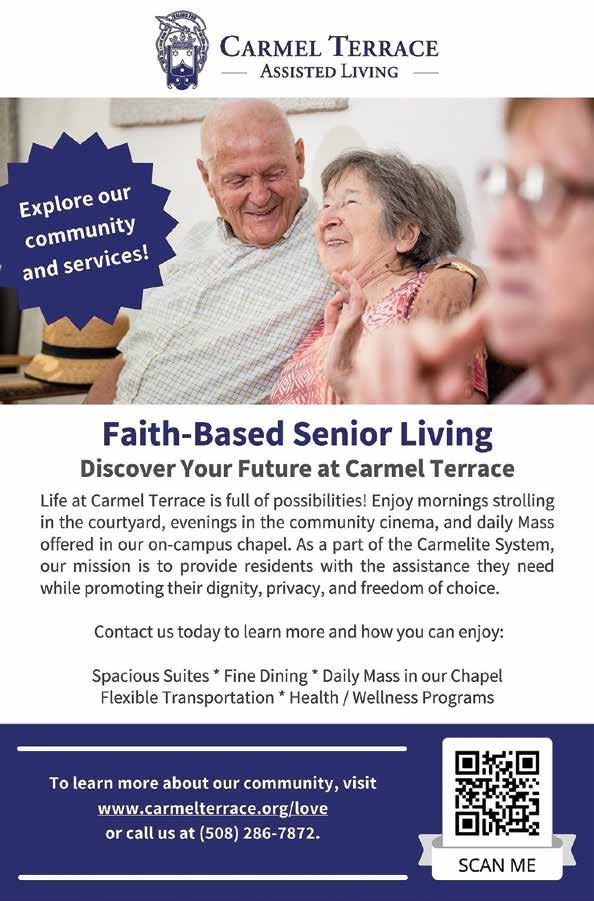
The program was or ganized by the St. Joseph Parish Pastoral Council and hospitality ministry in collaboration with oth er ministry groups of the parish.
Those recognized on Saturday were: Father Fintan Sheeran, SSCC, 72nd year Religious Pro fession; Father Colum bian Crotty, SSCC, 70th year Religious Profession; Father Michael Shanahan, SSCC, 60th year Priestly Ordination; Father Rob

ert Charlton, SSCC, 50th year Religious Profession; Sister Manorama Thomas, MC, 50th year Religious Profession.
Flo and Allen Days, 65th Wedding Anniver sary; Marie and Stanley Burt, 65th Wedding Anniversary; Barbara and Ralph Wright, 63rd Wedding Anniversary; Joan and Larry Collins, 63rd Wedding Anniver sary; Rhody and Richard Medeiros, 62nd Wedding Anniversary; Carol and Sonny DeTerra, 61st Wed ding Anniversary; Aline and Dennis Duval, 60th Wedding Anniversary; Domingos and Maria Pin to, 50th Wedding Anni versary; Fatima and Jose Ambar, 50th Wedding Anniversary; and Doug and Nancy McGee, 50th Wedding Anniversary.
Previously printed by Beth David, editor, in the Fairhaven Neighborhood News and used with per mission.
† November 11, 2022
Couples and members of religious orders pose for a picture during the Golden Jubilee celebration at St. Joseph Church’s Golden Jubilee celebration on Octo ber 15. (Photo by Carol Renaux)
Collection for religious is December 10-11 in diocese

continued from page one
of U.S. religious com munities face a large gap between the needs of their older members and the funds available to support their care. As a result, many now lack adequate retirement savings.
The 2021 appeal raised nearly $28.5 million, and the NRRO distrib uted funding to 271 U.S. religious communities. Donations also under write resources that help religious communities im prove elder care and plan for long-term retirement needs.
In 1988, Catholic bish ops of the United States launched the Retirement Fund for Religious to ad dress the significant lack of retirement funding for Catholic Sisters, Brothers, and priests in religious orders.
• For most of their lives, elder religious worked for little to no pay. There were no 401(k) plans or pensions.
• Religious communi ties are financially re sponsible for the support and care of all members. Income, earnings, and expenses are managed separately from the parish and diocesan structures of the Catholic Church.
• Only seven percent of the religious communi ties providing data to the National Religious Retire ment Office are adequate ly funded for retirement; 43 percent have 25 or few er members. Many small communities struggle to care for elder members due to a lack of financial resources and personnel.

• Today, religious past age 70 outnumber
religious under age 70 by nearly three to one.
• There are 24,924 religious past age 70 living in the United States. In 2021, the average annual cost for their care was roughly $50,000 per per son; skilled care averaged $78,000 per person.
• Since 2009, the annual cost to support senior women and men religious has exceeded $1 billion.
• In 2021, 70 percent of the religious communi ties providing data to the National Religious Retire ment Office had a median age of 70 or higher.
• The average annual Social Security benefit for a religious is $7,326, whereas the average US beneficiary receives $19,896.
• Each year, hundreds of U.S. religious commu nities receive financial assistance made possible by the Retirement Fund for Religious. Communi ties can use this funding for immediate retirement expenses or invest it for future needs. Since the first collection, U.S. Cath olics have donated nearly $948 million.

• Since the collection began, almost $817 mil lion has been distributed to support the day-to-day care of elderly Sisters, Brothers, and religious or der priests. An additional $102 million has been allocated for programs to assist religious institutes with comprehensive re tirement planning.
• In addition to di rect financial assistance, proceeds from the annual collection underwrite ed
ucational programming, services, and resourc es that enable religious communities to evaluate and prepare for long-term retirement needs.
• Support from the Retirement Fund for Reli gious helps religious com munities care for senior members while continu ing important ministries to the people of God.
The National Religious Retirement Office coordi nates the annual national appeal for the Retirement Fund for Religious and distributes financial assis tance for retirement needs to eligible religious insti tutes. To help address the deficit in retirement fund ing among U.S. religious orders, Catholic bishops of the United States initi ated the Retirement Fund for Religious Collection in 1988.
For more information, visit retiredreligious.org, or contact Robin Cabral, Campaign Director, by phone at (508) 685-8899 or email at robincabral@ retiredreligious.org.
Diocese to present Women’s Advent Retreat

EAST SANDWICH —
The diocesan Secretariat for the New Evangelization is of fering area women a “Prepare the Way: A Women’s Advent Retreat,” a new opportunity for women and women’s min istries across the diocese. It is an opportunity to pause their holiday preparations in order to adore Jesus like Mary did in the manger.
The retreat will feature speakers Allison Gingras and
December 10
Liz Cotrupi-Pfunder. Allison is a mother, speaker, Cath olic media specialist, and award-winning author with OSV and Ave Maria Press; Liz is a mother, musician, songwriter, and speaker.
The cost is $15 and includes Mass, continental breakfast, lunch, keynote talks, discussion, Adoration and Confession. To register, visit https//bitly/ prepare1210
November 11, 2022 3
Seeking the spiritual side of dementia


The possibility of suffering from dementia later in life is a worrisome and unpleasant prospect for many of us. Most people I know would like to remain in possession of their mental faculties until the end. Stephen Post, director of the Center for Medical Humanities, Compassionate Care and Bioethics at Stonybrook University describes it this way:
“The leading symptoms of dementia are, frankly, terrifying: loss of memory, of language, and of reason ing ability. We all feel at least a slight anxiety about dementia because these dreaded symptoms seem to assault our very identi ties, to dissolve the autobi ographical narratives that constitute the very story of our lives.”
The dreaded symptoms of dementia may lead to spiritual temptations. The prospect of losing auton omy and control can lead some to despair and even attempt suicide.
What can we say about the meaning of a life-changing reality like dementia for ourselves and our loved ones? Could it be that God is seeking to carry out a particular spiritual work?
For some who face dementia, it can have the effect of getting them off the treadmill and detaching them from those aspects of their lives that may be binding them, whether it’s work and career, hobbies or pastimes, or something else that may be drawing them away from a needed spiri tual focus.
In one of his articles, Stephen Post mentions Peter, who through his struggle with a diagnosis of Alzheimer’s, experienced
a spiritual reawakening and encountered the Lord’s grace: “I’d say, ‘Why did you let this happen to me? I had such a good career. Everything was going fine for me.’ He would say to me probably, ‘Well, why did you fight it? I was trying to lead you in this direction.’
Oh, I didn’t real ize that. Well, I’ve come to the con clusion that every thing has a pur pose, so the Good Lord, He knows the best for you. So maybe this was to slow me down to enjoy life and to enjoy my family and to enjoy what’s out there. And right now, I can say that I’m a better person for it, in apprecia tion of other people’s needs and illnesses, than I ever was when I was working that rat race back and forth day to day.”
It can be very hard for a family, especially a spouse, to watch the slow destruc tion of a loved one’s facul ties. At times the person suffering from dementia can become so frustrated they are aggressive towards those around them. There is need for a great deal of patience and spiritual and social support in these situations.
The lives of caregivers tend to be upended and changed profoundly by caring for a family mem ber, relative or friend with dementia, and the gener ous love they share is itself often sustained by faith in God. As caregivers watch their loved ones with “deep forgetfulness” disengage from the people around them, and from other pre viously important reference points in their lives, they also witness the emergence
of an unmistakable simplic ity in those they care for.
In a 2010 essay, Mary Anne Moresco beautifully sums up her dad’s and her family’s transformative spiritual journey this way: “My 83-year-old father has dementia. He can remember things that happened a lifetime ago
like it was yesterday, but he often can’t remem ber yesterday at all… My father needs this time in life. And we, his children, need it too. We need to glimpse into his past days, as he journeys backward. We need to show him love, as best as we can. We need to offer up our prayers for
him. This time is useful. It is valuable. For every thing there is a season, and this winter season of my father’s life is part of what will help guide his soul into eternity. Dad, through his dementia is working out his salvation. He isn’t doing that the way his chil dren wanted him to do it. He isn’t doing that the way he wanted to do it. He is do ing it the way God has deemed that he must do it. ‘… unless you become like little children, you will not ender the Kingdom of Heaven.’ (Matt: 18:3)… With each passing month, my father grows more humble and more child like, more dependent and more trusting and I do not doubt, closer to our Lord and to Heaven.”
As the symptoms and complications of demen tia unfold, the challenges
we face from the disease can unexpectedly become an invitation from God. Although dementia can contribute to spiritual growth, it almost always involves a great deal of suffering for all concerned, and the challenges should not be underestimated. Such moments, neverthe less, offer important oppor tunities to grow in grace, to slow down, to reevaluate our priorities and to en ter into a more profound relationship with Him who is our final destination and abiding hope.
Anchor columnist Fa ther Pacholczyk earned his doctorate in neuroscience from Yale and did post-doctoral work at Har vard. He is a priest of the Diocese of Fall River, and serves as the director of Education at The National Catholic Bioethics Center in Philadelphia. See www. ncbcenter.org and www. fathertad.com.


† November 11, 2022
A Certificate of Recognition was presented to Sister Marie William, a member of the Dominican Sisters of the Presentation for more than 67 years, at the Dighton Board of Selectmen’s meeting on October 12. She had just celebrated her 90th birthday. The presentation was given to recognize and thank her for dedicated service to the community. From left to right: Michael Mullen, Town Administrator; Nancy Goulart, former selectman; Sister Marie William Lapointe; Leonard Hull, Chairman, Board of Selectmen; and Kenneth Pacheco, Selectman. (Photo by Tom Ferry)
In this month of No vember dedicated to a Church-wide meditation on the four last things and to the practical imperative to become holy, so that after death and judgment we might enter eternally into communion with all the saints whom we celebrate on November 1, it is important that we will the appropriate means to that glorious end.

“The Eucharist,” as Pope Benedict wrote in 2007, “is at the root of every form of holiness, and each of us is called to the fullness of life in the Holy Spirit. How many saints have advanced along the way of perfection thanks to their Eucharistic devotion! … Holiness has always found its center in the Sacrament of the Eucharist” (Sacramentum Caritatis 94).
As the Church universal marks this autumn the 60th anniversary of the start of the Second Vatican Council with its emphasis on the uni versal call to holiness, and as the Church in the United States enters more deeply into its multiyear Eucharistic revival, it is a time to recog nize more clearly that the root and route of holiness is Eucharistic.
Someone who teaches us this truth in a compellingly attractive way is one of the co-patrons of the Eucharistic Revival, Blessed Carlo Acutis (1991-2006), the first millen nial to be raised to the altars.
Carlo was raised in a non-practicing home, but thanks to the influence of grandparents, a Polish nanny and his Catholic school, he began to hunger for Jesus in the Eucharist in such a way that he successfully begged to be able to make his first Holy Communion a year early, at the age of 7. There upon, he became a daily Mass goer and a Eucharistic apostle, not only bringing his parents back to the practice of Sunday Mass but also
The highspeed lane to holiness
zealously trying to bring his non-practicing peers to grasp the awesome gift they were neglecting.
He soon discovered that the most effective means help his fellow students and friends be captivated by the wondrous reality of the Real Presence of Jesus were his descriptions of the Eucharis tic miracle of Lanciano and the miraculous communion of the three shepherd chil dren in Fatima. That led him on a quest to get to know all the Eucharistic miracles by which God has buttressed the Church’s Eucha ristic theology and practice with divine confirmation.
His parents generously accom panied him to the sites of the miracles and, at age 11, he learned comput er programming to build a website to catalogue and promote these theophanies, not just to bring his friends in Milan but people all over the world to greater Eucha ristic faith, amazement and life. His catalogue eventually grew to a 196-part series that was exhibited in the Vatican in 2005 during the Year of the Eucharist and continues posthumously to travel the global.
If Carlo had not died somewhat suddenly of acute promyeolocytic leukemia in 2006, he would be just 31 years old today. Yet in record speed for someone so young — especially for someone who is not a child martyr or a recipient of Marian ap paritions — we are already celebrating him at the altar each October 12. His life shows us that we don’t need long years of life to become holy, but to avail ourselves of the means God provides. The greatest of those means is the Holy Eucharist.
“The Eucharist,” Car lo said, “is my highway to
Heaven.” And he sped on that highway faster than most young Italians like to drive on the autostrada. He spent his eight years after his first Communion trying to get as many as he could to join him on that expressway.
He became a catechist and sought to help the students entrusted to him to pursue holiness through a Eucharistic life. He created for them a “Holiness Kit” with nine practices, two of which were explicitly geared
grade them from coming to Mass out of duty when mor ally they must to coming out of love as often as they can. He wanted to get them off the winding, slow, stumbling trek through life onto the supernatural superhighway.
“I think that many peo ple do not fully understand the value of the Mass,” he said with candor and clarity, “because if they recognized the enormous blessing we have in a Lord who gives Himself as our food and drink in the Sacred Host, they would go to Mass every day to participate in the fruits of the sacrifice and let go of so many superfluous things.”
especially his classmates and catechetical students, to re late to Jesus in the Eucharist with similar practicality.
“If we think about it, we are more fortunate than those who lived 2,000 years ago in contact with Jesus, because we have God really and substantially present with us always. It’s enough to visit the closest church! We have Jerusalem on our doorsteps. Jerusalem is every church! If only people visited tabernacles with the same devotion!”
to helping them to live a Eucharistic life: “Try to go every day to Mass and to receive Holy Communion. … If you can, stay a few minutes every day in Eucha ristic adoration in front of the tabernacle where Jesus is really present, and you will see your level of holiness increase considerably.” He practiced what he preached — and his level of sanctity indeed grew swiftly and sub stantially.
With childlike simplic ity, yet precocious maturity and wisdom, he taught, “The more often we receive the Eucharist, the more we become like Jesus.” If in gen eral we become what we eat, when we receive Jesus with faith and love, we gradually become more and more like Him whom we consume. We begin to live because of Him, as Jesus promised we would during his Bread of Life discourse in the Capernaum Synagogue (Jn 6:57).
That’s why it wasn’t enough for Carlo just to get others to come to Mass on Sunday and to receive Jesus worthily. He wanted to up
He had great faith in the power of Jesus in the Eucharist to make us saints.
“You go straight to Heav en,” he said, “if you partici pate in Mass every day.”
Of course he was talking about far more than just at tendance, but truly entering into holy communion of life with Him who is holy, holy, holy. He had surprised his parents and friends after his first Communion by saying, “To be always united to Jesus — this is my program of life,” and attendance at daily Mass and loving reception of Holy Communion were the means of that union.
He received Jesus with recognition of what he was doing and Whom he was receiving.
“Jesus,” he would pray, “come right in! Make your self at home!” He received Jesus not just for a brief visit but as a permanent com panion. And he cherished the time in His company. He sought to make a Eucharistic holy half-hour every day. Whenever he would find an open Church, even when he was in a hurry, he would pop in just to say “hello” to Jesus.
He sought to help others,
He added, “You see queues in front of a soccer match or an actor or rock singer, but you don’t see a queue for the taberna cle where there is the Real Presence of God who lives among us.”
He tried to help his friends choose differently than the crowds. In perhaps his most famous words, which give witness to the depth that a life of prayer before Jesus in the Eucharist brought him, he said, “All of us are born as originals, but most of us die as photocop ies.” We model ourselves on others in their mundane su perficiality rather than unite ourselves to God, which not only makes us holy but fully human.
“God has written for each of us a unique and unrepeatable story,” Carlo insisted, “but He has left us free to write the end of the story.”
In the month of Novem ber, together with the whole Church, we ponder what we want the end of that story to be.

And Blessed Carlo, by his words, example and in tercession, wants us join him on the Eucharistic highway that will lead to the indelible inscription of our name in the Book of Life.
Father Landry is Interim Executive Editor. fatherlandry@ catholicpreaching.com.

November 11, 2022 5
Thinking ahead and preparing well
Throughout the month of November, the Church ponders the last things, and on All Souls Day, the Church not only prays for the faithful departed but focuses on the reality of death as a part of everyone’s life. Dying is our last moral action. Whether it takes place at the end of a long life or protracted illness, or whether it takes place suddenly even in the spring time of life, it is meant to be a faith-filled entrustment and self-offering to the God who gave us life and whom we hope will mercifully grant us life to the full.
The Church’s devotional tradition has encouraged us to live every day as if it were our last so that when our last day comes, we will be ready. It’s been called the ars moriendi, the art of dying well. Thomas à Kempis wrote in the spiritual classic “Imitation of Christ,” “Happy is the man who has the hour of his death always before his eyes and daily prepares himself to die. … When it is morning, reflect that you shall not see the evening, and at eventide dare not to boast yourself of the morrow. Always be prepared and so live that death may never find you unprepared.”
When Christ comes for us, He wants us to embrace Him with longing rather than find Him as a “thief in the night” (Mt 24:43). As Cardinal Justin Rigali wrote in 2011, rehearsing our death each day gives us the opportunity to say daily with Christ, “No one takes my life from me; I freely lay it down” (Jn 10:18) and “Father, into Your hands I commend my spirit” (Lk 23:46). If we do so, then our death whenever it comes will become the emphatic reitera tion of the way we have lived.
To prepare well for a holy death should involve proper formation about the Sacrament of the Anointing the Sick, the first purpose of which is to help us unite our sufferings and death to Christ’s passion, death and resurrection.
The Sacrament of the Anointing of the Sick is the most misunderstood, underappreci ated and neglected of the seven Sacraments. While there is generally extensive preparation for adult and child Baptism, first Confession and first Holy Communion, Confirmation, Matrimony and Holy Orders, most receive little preparation for the Sacrament of the Anoint ing of the Sick. As a result, many even practicing Catholics know little about it and the little that they do know is often second-hand and erroneous. Very few Catholics, therefore, are prepared to receive it.
That’s why Roger W. Nutt’s new book, “To Die is To Gain: A Theological (Re-)Introduc tion to the Sacrament of Anointing of the Sick for Clergy, Laity, Caregivers and Everyone Else,” published earlier this year by Emmaus Academic, is a very timely and helpful resource.
Nutt, provost and theology professor at Ave Maria University, provides us with an easyto-read, clear and theologically accurate primer on the Sacrament of the Anointing the Sick, which contextualizes it not only in Church history but in contemporary questions, practices and misunderstandings. He helps us to see the crucial importance of the Sacrament as part of life and as a Christian response to the modern phobia of suffering and death.
“Western culture,” Nutt writes, “is currently in a crisis about the meaning of life, suf fering, and death. We live at a time in which the doctrinal message of the Sacrament of the Sick and the graces that it confers are needed — more than ever. We live in a time in which the loss of an awareness of the significance of this Sacrament is catastrophic. Anointing of the Sick is a proclamation and application to the dying of Christ’s victory over death. … This Sacrament should be at the forefront of thinking about the Gospel message for those facing death, and it should be something that we desire for ourselves and our loved ones as we con template mortality and are confronted by death.”
He makes several important clarifications about the Church’s teaching on the Sacrament.

The first is with regard to the proper recipient. Quoting the Second Vatican Council,




the Code of Canon Law, the “Catechism of the Catholic Church” and modern popes, Nutt re iterates that the Sacrament is meant to be administered to “those who are in danger of death due to illness or old age.”
This means that the Sacrament does not need to be delayed until the person is about to take the last breath because its first effect is to consecrate the person to God in suffering, so that the person may more efficaciously offer his or her weakness, pains and eventual death to God in union with Christ’s redemption.
But it also means that it is not meant to be administered to those who are not in danger of death due to sickness or senescence.
It’s not meant, Nutt writes, for those “who are sick or injured but in no way in danger of death, like those getting their tonsils out, or having arthroscopic surgery, or just feeling under the weather, or anyone over a certain age. Not everyone in a hospital or nursing home needs anointing, because not all are in danger of death. Certainly not everyone in a parish at a ‘healing Mass’ is in danger of death.”
Neither is it intended for those who have “a cold or a flu,” who are “feeling off emo tionally,” or who are experiencing an “external threat to life such as war, natural disaster, crashing planes, sinking ships, or even the death penalty.”
It’s meant, exclusively, to be given to those who are in danger of dying because of the in ternal conditions of life-threatening malady or old age. It is proper to be given to those going in for open heart surgery, but not for arthroscopic surgery or a root canal.
Another important clarification Nutt makes is that while miracles of physical healing have occasionally been associated with reception of the Sacrament, the purpose of the Sac rament is as a remedy to the “primary illness every human being suffers from,” namely, “sin and its effects,” as the “spiritual antidote to the bodily remnants of sin that remain in each human being.”
Christ didn’t establish the Sacrament “so as to deprive those facing death from having to die,” he writes, but so that “they can die in union with Him without being overcome in their weakened state by the bodily vulnerabilities and temptations that sinning can make us susceptible to.”
Nutt expresses the concern that “if the primary expectation of the sick and their loved ones is for the avoidance of death by obtaining a miraculous cure, then they are fixed on a false hope that is not consistent with the message of the Gospel. … If a miraculous cure does not happen, it is not because the Sacrament lacks power or efficacy, but because the ‘greater’ miracle is the healing from the effects of sin so that we can die in union with Christ and enter into eternal glory.”
“This truth should be a consolation, not a disappointment,” he states, because “the Christian faith offers the sick and dying much more than mere optimism that God might give a miracle.”
After all, the purpose of the Sacrament, as indicated by the words of St. James that priest echoes during the anointing, is that “the prayer of faith will save the sick man, and the Lord will raise him up.”
The Sacrament of the Anointing of the Sick, therefore, is meant to be a “sign of definitive conversion to the Lord,” “of total acceptance of suffering and death as a penance for sins,” and of hope for the “supreme reconciliation with the Father.”
It is the fruit of a Christian’s proper preparation for death, the highest expression of the ars moriendi, and an important part of the Christian life lived well.
Nutt’s book is important reading for every Catholic this November.
Daily Readings † November 12 - November 25
Sat. Nov. 12, 3 Jn 5-8; Ps 112:1-6; Lk 18:1-8. Sun. Nov. 13, Thirty-third Sunday in Ordinary Time, Mal 3:19-20a; Ps 98:5-9; 2 Thes 3:7-12; Lk 21:5-19. Mon. Nov. 14, Rv 1:1-4; 2:1-5; Ps 1:1-4,6; Lk 18:35-43. Tue. Nov. 15, Rv 3:1-6,14-22; Ps 15:2-4b,5; Lk 19:1-10. Wed. Nov. 16, Rv 4:111; Ps 150:1b-6; Lk 19:11-28. Thu. Nov. 17, Rv 5:1-10; Ps 149:1b-6a,9b; Lk 19:41-44. Fri. Nov. 18, Rv 10:8-11; Ps 119:14,24,72,103,111,131; Lk 19:45-48.
Sat. Nov. 19, Rv 11:4-12; Ps 144:1-2,9-10; Lk 20:27-40. Sun. Nov. 20, Christ the King, 2 Sm 5:1-3; Ps 122:1-5; Col 1:12-20; Lk 23: 35-43. Mon. Nov. 21, Rv 14:1-3,4b-5; Ps 24:1b-4b,5-6; Lk 21:1-4. Tue. Nov. 22, Rv 14:14-19; Ps 96:10-13; Lk 21:5-11. Wed. Nov. 23, Rv 15:1-4; Ps 98:1-3b, 7-9; Lk 21:12-19. Thu. Nov. 24, Rv 18:1-2,21-23; 19:1-3,9a; Ps 100:1b-5; Lk 21:20-28. For Mass of Thanksgiving to God, Sir 50:20-24; Ps 138:1-5; 1 Cor 1:3-9; Lk 17:11-19. Fri. Nov. 25, Rv 20:1-4, 11—21:2; Ps 84:3-6a,8a; Lk 21:29-33.
† November 11, 2022
Editorial OFFICIAL NEWSPAPER OF THE DIOCESE OF FALL RIVER Published biweekly except for one week in autumn by the Catholic Press of the Diocese of Fall River, 887 Highland Avenue, Fall River, Mass. 02720 , Tel. 508-675-7151 ; FAX 508-675-7048 ; email: davejolivet@anchornews.org To subscribe to The Anchor online visit www.fallriverdiocese.org;subscribe Subscription price by mail, prepaid $29.00 per year for U.S. addresses. Please send address changes to The Anchor, PO Box 318, Congers, NY 10920, call or use email address. PUBLISHER – Most ReveRend edgaR M. da Cunha, s d v., d d Vol. 66, No. 22 EDITOR; PRODUCTION MGR. david B. Jolivet davejolivet@anchornews.org EXECUTIVE EDITOR FatheR RiChaRd d. Wilson INTERIM EXECUTIVE EDITOR FatheR RogeR J. landRy - fatherrogerlandry@anchornews.org ADVERTISING Wayne R. PoWeRs waynepowers@anchornews.org POSTMASTERS send address changes to The Anchor, PO Box 318, Congers, N.Y. 10920. THE ANCHOR (USPS-545-020) Periodical Postage Paid at Fall River, Mass.
Students and Bishop Edgar M. da Cunha, S.D.V., presented FACE Fall Dinner guest speaker, New England Patriot Devin McCourty,
FACE Fall Dinner raises more than $300,000
continued from page one Education Award to Sandra Sevigney in recognition of her leadership and unwavering support of Catholic schools. Sevigney was instrumental in fundraising for St. Mary’s Education Fund, was a FACE board member, and

chaired the FACE Fall Dinner event from 20142016.
Brendan Resende, a se nior at Bishop Stang High School, shared his person al journey as a Catholic school student, which be gan at Holy Name School in Fall River. Resende is
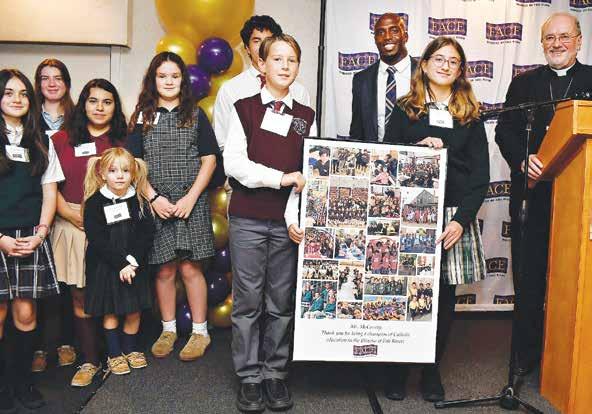
grateful for the strong aca demic foundation that has also nurtured his faith and plans to continue his ed ucation at Fordham Uni versity next year. “To all those who have come out tonight and have helped make not only my dream a reality, but thousands of others both in elementary and high school, thank you.”
Guest Speaker, New England Patriots threetime Super Bowl Cham pion and Team Captain, Devin McCourty, captivat ed the crowd as he spoke about his own Catholic school experiences and how it helped shape his strong faith, his life and career. McCourty said, “Had it not been for fi nancial aid from his high school, my success story might not have happened. It is great when you get to support causes, not only do you believe in, but what you benefited from.
Putting me in that envi ronment as a kid brought out the best of me and taught me a lot of disci pline and ways to become a good human being,” McCourty continued. “If I could help out young peo ple to get that opportunity, I want to be there to help them out.”
“It is incredible to have Devin here, being a champion for Catholic education,” Chief Execu tive Officer of the Catholic Foundation of Southeast ern Massachusetts Miri am “Mim” Sherman said. “We’re so used to seeing Devin playing at Gillette Stadium. But to hear him tonight talking about his
faith and the importance of Catholic education is just so meaningful.”


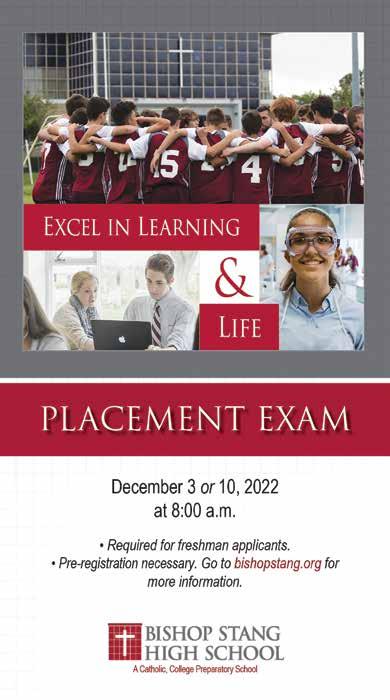
Bishop da Cunha closed the program with a prayer and by inviting an excited group of stu dent volunteers to present McCourty with a special photo collage represent ing each school in the Diocese of Fall River, as a small token their appreci ation for his believing in FACE’s mission and being part of this special annual event.
For more information about the Foundation to Advance Catholic Education and to make a donation, please go to www.FACE-dfr.org.
November 11, 2022 7
with a special gift.
Bishop da Cunha with Timothy J. Cotter Award Re cipient Sandra Sevigney and her husband Mark. The award is in recognition of her leadership and support of diocesan Catholic Schools.
You’ve got to be carefully taught …
I’m sure most of us re member the Tony and Pulitzer Prize winning mu sical, “South Pacific.” They just don’t write them like that anymore! The score was written in 1949 by Richard Rodgers and Oscar Hammerstein and is filled with memorable pieces that are part of the American songbook: “Younger Than Springtime,” “I’m Going to Wash That Man Right Out of My Hair,” and “ There is Nothin’ Like a Dame.” One song that is perhaps not as well known is “You’ve Got To Be Carefully Taught.”
When the show opened in 1949 it was quite con troversial; it spoke about how impressionable young children are and how hate and prejudice are learned behavior. “You’ve got to be
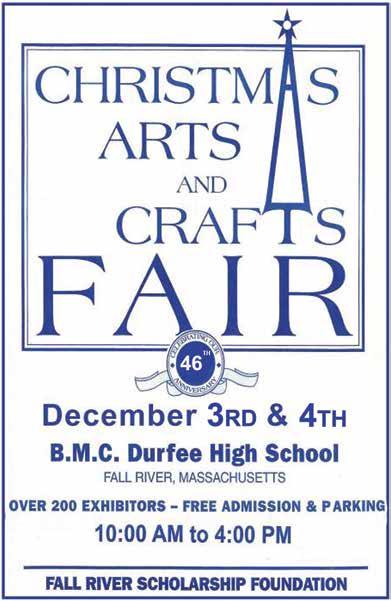
taught from year to year it’s got to be drummed in your dear little ear.” Obviously the lyricists understood how impressionable chil dren are, how their atti tudes and impressions are developed at a very early age, and how they carry over into adulthood what they learn as children.
I was saddened to read a story on social media the other day. It was written by a mother in my little hometown. Her daughter, a second-grader, came home in tears after being tormented and bullied on the school bus. One of her classmates had called her names, and made fun of her for the color of her skin and
other physical attributes. My mind immediately went to that song that was written decades before:
“You’ve Got To Be Careful ly Taught!” Where would a second-grader learn hate


speech and ethnic slurs?
Maybe from his or her parents? Maybe from older siblings or their friends? Maybe from watching inappropriate television or videos? I guess it hardly matters. The fact is that somehow, somewhere, a small, precious child heard and learned words and lan guage that are unacceptable at any age.
Some people will say that the problem of prej udice and hate is a re cent problem, but it isn’t. There are examples of hatred throughout histo ry, throughout the Bible.
It’s been around as long as time. I remember when I was in first or second grade, there was a girl that I did not like. I remember coming home and telling my mother, “I hate Susie Jones!” (Not her real name.) My mother told me that I was not allowed to use the word hate, especially in that context. I was allowed to say that I “strongly disliked” her. Those words didn’t quite have the same impact. My mother was right, as she was more often than not.
As it turns out, “Susie” and I were classmates up to and through our high school years. We lost track of each other for a while during college, but afterwards our paths crossed and we ac tually wound up becoming the best of friends. “Susie” confessed to me at some point in time that she, too, would go home and tell her mother how much she hat ed me; we had a good laugh about that.
I can’t tell you why I
“hated Susie,” or why she “hated” me. But I do know this — my mother made it very clear that there was no tolerance for hate speech in our house. It’s a lesson I never forgot. We live in difficult times.
As Catholics and as Christians we are called to model what we believe and share what we know with our children. We are our children’s first teachers. What they learn at our knee will be taken into their adult lives. It will become “gospel” to them, so it’s important that we teach them the Gospel of Jesus Christ. We cannot rely on others to shape and form our chil dren morally or ethically. Of course our religious educa tors are part of their Chris tian formation, but make no mistake — children learn what they live and live what they learn. Now, perhaps more than ever, our children need and deserve strong roots and role models. If we speak the language of love, so will they. If we speak the language of compassion, so will they. And if we speak of God’s goodness and love, if we tell them of His Son, Jesus Christ, we teach them the beauty of living a life of faith, love, and joy. They’ve got to be carefully taught! And that my friends, is the Good News.
“Start children off on the way they should go, and even when they are old they will not turn from it” (Prov 22:6).
Anchor columnist Ada Simpson is former editor of Ministry and Liturgy magazine, holds an M.A. in Pastoral Ministry, and is the director of Music Ministry at St. Francis and St. Dominic parishes in Swansea.


† November 11, 2022
A group of Religious Education students from Holy Trinity Parish in West Harwich, take a break at the Alzheimer’s Family Support Center’s Walk for Alzheimer’s in Provincetown on October 16. The outing was part of the parish’s program entitled, “Love Thy Neighbor as Thyself.”








An ”Important Aging Information Seminar” was recently held at Holy Trinity Parish in West Harwich. More than 90 in attendance heard eight speakers, including Captain Leighanne Smith from Harwich Fire Department; Barbara-Anne Foley, Outreach and Programs Manager at Cape and Islands Veterans Outreach Center and Director of Religious Education Program at Holy Trinity Church in West Harwich; and Susan Jusell, Harwich Town Nurse.

November 11, 2022 9
www.anchornews.org Visit The Anchor online at
The Camino de Santiago: The journey of a lifetime
EASTON — Joe Gelly and Eddie Alicea recent ly made a pilgrimage that many only dream of.
They trekked the French Way of the Camino de Santi ago, an ancient religious pil grimage walked by 350,000 people each year.
For more than a thou sand years, the Camino de Santiago — the Way of St. James culminating at the tomb of the apostle St. James the Greater in the Cathedral of Santiago de Composte la — has deeply inspired Christians from around the world. The trek is a haven for prayer and self-reflection and serves as a reminder that the slow and deliberate journey is often as deeply meaningful as the destination.
Joe and Eddie’s hike be gan in St. Jean-Pied-De-Port in southern France, before traversing the Pyrenees Mountains and continuing
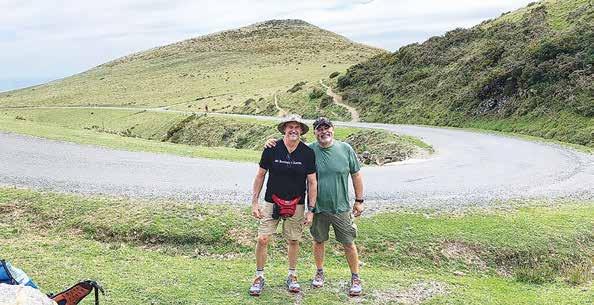


through La Rioja region and along the rolling hills of northern Spain.
Joe and Eddie finished their pilgrimage on October 12 after six weeks on the trail, finishing at the burial place of St. James.
The two raised nearly $29,000 in support of My Brother’s Keeper’s Easton Building Project.
In addition to their per sonal motivations, Joe and Eddie decided to make their pilgrimage even more pro found by taking this oppor tunity to raise funds for My Brother’s Keeper, a Christian ministry that provides food, furniture, and Christmas assistance to local families and individuals in need — free of charge and without prerequisites.
Joe shared his thoughts as he was approaching the end of the pilgrimage: “Along the way, they found a deep
appreciation for all we have been blessed with in life. The feeling is bittersweet as we approach the end of our pilgrimage. Our bodies are exhausted, we miss our friends and family dearly, but the Camino community and shared experience in Christ’s name will be hard to leave behind. We can feel the strong Faith around us and will miss the hundreds of pilgrims who never hesitat ed to do the right thing and help each other, no questions asked, every step of the way.”


Donations in honor of Joe and Eddie’s pilgrimage will support the charity’s Easton Building Projectmajor renovations that will significantly strengthen the organization’s ability to de liver furniture, food, Christ mas gifts, and most impor tantly, the love and hope of Jesus Christ, to struggling families. Over the next 20 years, the renovations will enable My Brother’s Keeper to complete 167,000 ad ditional deliveries, worth $53,000,000, helping local
families in need.

The Lynch Foundation has generously offered to match every dollar raised through this important initiative!
To learn more about My Brother’s Keeper or to request assistance please visit their website at www. MyBrothersKeeper.org or call 508-238–7512.
A full photo gallery of their trip can be viewed at https://www. mybrotherskeeper.org/thecamino/
† November 11, 2022
Joe Gelly, left, and Eddie Alicea spent six weeks on the French Way of the Camino de Santiago, beginning in France and ending in Spain. Together, they raised nearly $29,000 to help support My Brother’s Keeper in Easton.
Since November is the month in which we focus on the saints, I’d like to introduce you to a very special friend of mine.
Some of you, I think, already know him, and you’ll recognize him as you read on. But in my humble opinion — not his, I dare say — not enough people are acquainted with him. He’s what I’d call my “goto guy” when I need help with something. His name is Solanus Casey, Blessed Solanus Casey OFM Cap., to give him his full title. The fifth anniversary of his be atification is next Thursday, November 17.
Let me provide an ex ample of what I’ve come to count on Solanus for. (Yes, we’re on a first-name basis).
A few weeks back I thought I had locked myself out of a company car. I was “on assignment” to pick up some incoming passengers at Logan Airport, and in the process of getting the required livery parking permit, I was shocked and horrified to realize that I didn’t have the vehicle keys. I retraced my steps back to the place I had parked, with no sign of any keys. I came to a sickening conclusion, that I had locked them in the vehicle. Even more alarm ing, my cellphone was in there, too, so I’d have no easy way of getting hold of my employers to let them know what had happened.
“Solanus, buddy, I need your help,” I blurted. It was not much of a prayer from a Liturgical standpoint, but certainly as heartfelt as any thing I had uttered in quite a while.
A voice — not a real voice, at least I don’t think so — said, “I’ve got this. Piece
Making a case for Blessed Solanus
of cake. Try not to be in such a hurry next time, OK?”
And sure enough, somehow the driver’s side door, which in my panic I thought I had checked, was open. It shouldn’t have been, because I had used the door switch to lock all the doors before getting out, but it was. The problem was solved, I breathed a sigh of relief the likes of which I hadn’t exhaled in many a moon. Then a prayer of thanks to my pal.
It’s trivial and certainly wouldn’t qualify as the miracle the Vatican is waiting for before they canonize Solanus. But in my world, it qualified.
One of the silliest of human thoughts, as least in mine, is the concept of Heaven as a vast office complex, where each saint has a cubicle and some of the cubicles, like St. Antho ny’s or St. Jude’s, are always humming with activity, while maybe St. Fidelis of Sigmaringen or St. Erc aren’t as busy and they spend a lot of time watching the celestial equivalent of ESPN. They will gladly intercede for us if we ask them, but what about Solanus? He’s not even a real saint yet!
Wikipedia has a nice ar ticle on Solanus, and there’s a website (solanus.org) that will provide many more



details on my friend than I can supply here. I first be came aware of him through a friend who was part of the Franciscans of the Primitive Observance who for several years had a friary on Rivet Street in New Bedford.
The Church has no shortage of saints and keeps adding new ones, but speak
think so.
ing as a non-theologian, I’m not sure why some candi dates for sainthood seem to be on what the secular world would call a “fast track” while a person of great holi ness like Solanus has to cool his wings.



Some friends of ours have been dealing recently with some grave childhood illnesses. Suffice it to say that things were looking grim. I encouraged them to ask Solanus’ help, which they promised to do. I told them I would keep pestering him, too. At some point I remem bered that one of Solanus’ favorite recommendations was, “Thank God ahead of time.” I passed that on to my friends and it seems that it helped turn the situation around for them and for their kids. A miracle? We all
One of the really won derful things I find about Solanus Casey is how real and down to earth he is. He liked sports and hot dogs and if he hadn’t lived in New York and Detroit, he’d prob ably have been a Sox/Pats/ Bruins/Celts fan. He played — or tried to play — Irish tunes on his fiddle, to the annoyance of some of his fellow monks. He basi cally had to jump through hoops to get through his ear ly religious training, where classes were taught in German and Latin, a fact that pre sented huge obstacles to an Irish kid from Wisconsin who didn’t speak German or Latin. But he stayed with it because the Blessed Moth er had told him to: “Go to Detroit,” she said.
The Capuchins decided that Solanus didn’t have the intellectual firepower for all aspects of priestly ministry, so he was ordained “simplex priest” with limited faculties to celebrate Mass, but not to preach or hear Confes sions. Instead, they decided that he would make a really good porter. But God and our Lady had other plans for Solanus, and the humble doorkeeper was soon recog nized as possessing extraor
dinary gifts to heal bodies and souls.
The Wikipedia article and the website will take you further into the life and painful death of this wonderful man. I can’t help but smirk at the thought of what young Bernie Casey’s superiors — now presum ably also in some corner of Heaven where they can chat merrily in German and Lat in — are thinking of their former student, the dumb Irish kid from Wisconsin who, once the Vatican gives the nod, will be the first Irish-American saint to be canonized!
If opening a car door and healing two very sick children don’t qualify as miracles enough, we’ll just have to find a few more.
Bill Black, from Bourne, is a “charter member” of St. Elizabeth Seton parish in North Falmouth. He mar ried for 53 years to the love of his life, blessed with two sons and four grandkids. Retired, he is also an Irish traditional musician and photographer of boats on the Cape Cod Canal.
November 11, 2022 11
Guest Columnist
Bill Black
and Y oung a
ATTLEBORO, MA

– Bishop Feehan High School President Tim Sul livan recently announced a new “Our City, Our Home” initiative, re-em phasizing the school’s long-term commitment to serving families from the school’s home city of Attleboro.
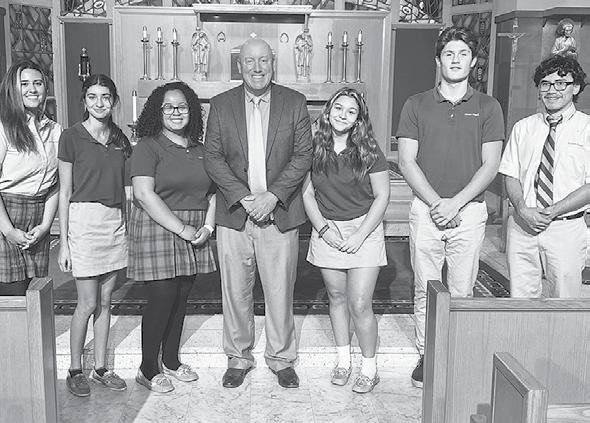
The program places a series of existing and new efforts from the school under a single umbrella, all focused on serving the city of Attleboro and its families. For 61 years now, Feehan has been Attleboro’s Catho lic high school, starting primarily for the families of Attleboro and North Attleboro and now serv ing students from more than 60 cities and towns annually.
But despite the im pressive geographic growth and more than $1
million in financial aid awarded annually across all Feehan towns, the school has not wavered from its commitment to its home city. As admis sions season for the class of 2027 began, Feehan was excited to announce this new effort to enhance accessibility for city fami lies specifically.
“Feehan always has been and always will be Attleboro’s Catholic high school,” pointed out Sullivan. “The families who built Feehan and the Sisters of Mercy who originally staffed our school shared a passion for keeping Feehan open and accessible to local families who desire a Catholic school educa tion and for playing a leadership role in our city. Today we reaffirm that commitment.”
“Feehan is a great
partner with the city,” added Attleboro mayor Paul Heroux. “The stu dents, the families, the employees all contribute to the diversity of our community. Many grad uates work in our city. Some are tradesmen and women. Others are small business owners. Feehan is an important part of the Attleboro communi ty.”
The highlight of the Our City, Our Home initiative is a dedicated admissions path and — perhaps more importantly — dedicated financial aid dollars for economical ly challenged Attleboro families under Feehan’s Ignite, Support and Em power (ISE) program. The goal is to make a Feehan education accessible for all local families looking for a rigorous, Catholic, college preparatory high school.
Additionally, Feehan will build on its existing efforts to serve the local community in a variety of ways. It is combining the following efforts under the Our City, Our Home umbrella:
Amigos — For nearly 25 years, Feehan Spanish National Honor Soci ety members have tu tored several dozen ESL students in Attleboro middle schools in a na tional award-winning, private-public partner ship.
Feehan Santa Shop —
Thousands of Christmas toys collected and an in spiring shopping experi ence for hundreds of local families in conjunction with the Attleboro area St. Vincent de Paul Society.
Thanksgiving Food Drive — Overflowing Thanksgiving baskets (and multiple grocery gift cards to go with) all bless ed by the bishop for the neighbors in need each November.
Special Olympics — Growing effort with doz ens and dozens of Feehan student volunteers serv ing local residents with physical and intellectual challenges.
Volunteer Connec tions — Several dozen Feehan programs and teams support individual Attleboro causes includ ing: La Salette Shrine, Empty Bowls, Hebron


Food Pantry, Robbins Children’s Program, Abundant Hope, Jaguars Track, Sock Drive for Food ’n Friends and many more.
Feehan is actively ex ploring additional oppor tunities to partner with Attleboro community organizations.
Attleboro residents wishing to learn more about the Our City, Our Home admissions and scholarship opportunities should contact Feehan’s Director of Admissions, Dustin Demers at ddemers@bishopfeehan. com.
Full details on Fee han’s Ignite, Support and Empower program serv ing aspiring first-genera tion college students and economically challenged families can be found at bishopfeehan.com/ignite.
† November 11, 2022
he
C h
Y
s
T
C hur
and
ou T h
dulT
Six Bishop Stang students have earned academic honors from the College Board National Recognition Programs. Corporation College Board Recognition recipients with President Benson, from left: Skyla Alves, Chantel Salem, Jasmine Duncan, Gianna Mo rales, Lukas Hirschmann, and Samuel Martin.
Bishop Feehan High School establishes ‘Our City, Our Home’ initiative, renewing commitment to Attleboro families and school’s home city
Preparing for Advent — God with us
The Church begins its new Liturgical year with the start of the Advent season, which is just over two weeks away. The Uni versal Norms on the Litur gical Year and the General Roman Calendar (1969) has this description of Advent: “Advent has a twofold character, for it is a time of preparation for the So lemnities of Christmas, in which the First Coming of the Son of God to hu manity is remembered, and likewise a time when, by remembrance of this, minds and hearts are led to look forward to Christ’s Second Coming at the end of time. For these two reasons, Advent is a period of devout and expectant delight” (39).
During Advent we can anticipate the coming of Christ from three perspec tives. The first is the birth of the baby Jesus in Beth lehem. The second is when Jesus comes again in glory
at the end of time. The third is when we accept Christ in the Sacraments, prayer and daily life. We should be aware that this daily com ing of Jesus happens as we open our hearts and minds to His presence. That’s part of the experience of Advent: waiting in anxious anticipation for something wonder ful that was prom ised. That promise is fulfilled in Jesus. The Word is fulfilled in our hearing when we prayerfully listen to Sacred Scripture. The Body and Blood of Christ is the seal of the new and eter nal covenant promised to us and fulfilled in our midst.
Music helps set the tone of the Advent season. Over the ages, seven antiphons came into use as part of the Liturgy of the Hours for Ad vent. They are called “O An tiphons” and highlight the many names of the Messiah
Diocese of Fall River TV Mass on WLNE Channel 6

Sunday, November 13 at 11:00 a.m.
Celebrant is Father Michael Racine, Pastor of Holy Name of the Sacred Heart of Jesus and St. Lawrence Martyr parishes and Parochial Administrator of St. Francis of Assisi Parish, all in New Bedford
Sunday, November 27 at 11:00 a.m.
Celebrant is Father Anthony V. Szakaly, C.S.C., Director of Campus Ministry, Stonehill College, Easton


used in the Old Testament:
• O Wisdom, O holy Word of God (O Sapientia)
• O sacred Lord of an cient Israel (O Adonai)
• O Flower of Jesse’s stem (O Radix Jesse)
• O Key of David (O Clavis David)
kind.
The Second Coming will be at the end of the world (Mt 24:30). It is called the Parousia, a Greek word that means “a coming” or “a presence.” It refers to Jesus’ “coming on the clouds with great power and glory” (Mk 13:26-27). It will be an unforgettable event because it will be accompanied by many remarkable signs. The Advent readings remind us always to be pre pared.
in history and expect His coming in majesty, we re member the four-fold ways we experience Him during the Mass: in the Word, in the Eucharist, in the pre siding priest, and in the faithful made in his image and likeness (Sacrosanctum Concilium 7). Seek the Lord where he can be found. We can find God-with-us everywhere.
May our hearts be open this Advent as we prepare to receive, experience and adore Emmanuel.
• O Radiant Dawn (O Oriens)
• O King of all the na tions (O Rex Gentium)
• O Emmanuel (O Em manuel)
Much of our Advent music draws from the O Antiphons. The seven verses of the hymn “O Come, O Come Emmanuel” are based on the O Antiphons. Unfor tunately, we hardly ever sing all seven at Mass.
At Christmas we cel ebrate the first Coming of Christ with the birth of the infant Jesus. His conception and birth were the humble beginning of his earthly life but the great beginning of the redemption of human
Christ also comes to us every day in our lives. This is a living presence and dynamic action of Christ all around us, today, right now. Jesus is our companion on the journey. This great jour ney of humanity that began with the birth of the infant Jesus and will end with His coming again in glory at the end of time. We never walk alone. God-with-us, Em manuel, is still with us.

We find Christ in the present. We find Him in the Holy Scriptures. We find Him in the Holy Eucharist. We find Him in prayer. We find Him in silence. We find Him in one another. As we remember His coming
Diocese of Fall River TV Mass on the Portuguese Channel Sunday, November 13 at 7 p.m. Broadcast from St. Anthony of Padua Church in Fall River
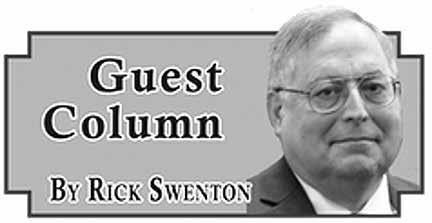
Diocese of Fall River TV Mass on the Portuguese Channel Sunday, November 27 at 7 p.m. Broadcast from Our Lady of the Holy Rosary Church in Providence
Rick Swenton is a parishioner of St. Pius X Church in South Yarmouth and is a member of the choir and a cantor. He has a certificate in Lay Minis try from the Archdiocese of Hartford with a focus on Liturgy and Music and is a published church music composer.
OLOG Christmas Bazaar is November 27 and 27
WESTPORT — THE 35th annual Christmas Ba zaar at Our Lady of Grace Parish Center, 569 Sanford Road, Westport, will take place Saturday, November 26, 9 a.m. to 3 p.m. and Sunday, November 27, 9 a.m to 2 p.m. There is no admission fee, and there is plenty of parking and handicap accessible.
There will be more than 30 craft tables, Elf’s Pot of Gold, Children’s Craft Table, Winner-Every-Time Table, U-Pic-Um Table, and BIG $$ Raffle.
Santa Claus, 11 a.m. to 12 noon both days (bring your camera). Christmas Music by Pat Cordeiro, 12 Noon to 2:00 p.m., as well as kitchen open both days.
November 11, 2022 13
Pope tells young people: Skip Google, search God first for advice
AWALI, Bahrain (CNS)
— Everyone needs help to mature and to grow as a person of faith, Pope Francis told young people in Bah rain, so reach out to some one a bit older and wiser and don’t forget to pray.
“Before you go to the Internet for advice, always seek out good counselors in life, wise and reliable peo ple who can guide and help you,” like parents, grandpar ents, teachers, the elderly and a good spiritual guide, the pope told students at Sa cred Heart School in Awali November 5.
“Each of us needs to be accompanied on the road of life!” he told them.
And turn to God, who is always there, waiting “for you to ask Him to give you a hand,” the pope said.
The principal of the Sa cred Heart School told Pope Francis that the schools’ 1,215 students from 29 dif ferent nationalities, cultures, languages and religious backgrounds were a “minia ture symbol” of the peaceful co-existence and culture of care he has called for.
“Your presence here with us will surely raise awareness about our cultur al diversity and shared be liefs, as well as our commit ment to establish a vibrant and respectful society for present and future genera tions,” Sister Roselyn Thom as, a member of the Sisters of the Apostolic Carmel, told the pope.
Students filled the gym and areas outside the school; some were wearing clothing traditional to their culture or religion. As the pope entered, a choir sang, “All are welcome in this place.”
In the 74 years since the sisters founded the school in Bahrain, “you have been its most treasured and most
revered guest,” Sister Thom as told him.
Another honored guest was school alumnus, Lt. Ab dulla Attiya. A member of the Bahrain Royal Guards, he broke a world record in December last year, running a marathon in full military gear in 3 hours, 40 min utes and 7 seconds, which also got him a place in the Guinness Book of World Records.
“I can be a champion on the field but what real ly matters is becoming a champion off the field,” he told the pope. Despite all the hard work, sacrifice, success and medals, he said, he realized the “trophies will eventually rust. It’s friend ship and fraternity that will last forever.”
As a Muslim at the school, he said he had “the opportunity to celebrate Christmas, Diwali and many other heart-warming feasts … with no discrimi nation if one participated in the other’s happiness.”
Speaking on behalf of all young people in Bahrain, Nevin Varghese Fernandez told the pope that growing up as a Catholic in Bahrain “was risk-free and secure, as we are blessed to be living in a country that promotes and supports various religions.”
“Living as a Catholic in a predominantly Muslim country is very joyful as we are surrounded by people of faith who share the same values, and the Church has given us a good foundation,” he said.
Young Catholics, he said, are grateful for the Church’s support and the “heroic examples of people risking their lives for the faith.”
He told the pope his visit “gives us strength and encourages us in our Catho lic identity.”
Merina Joseph Motha also told the pope of the strength her Catholic faith and community have given her.
“Believe in God and believe in yourself, and the rest will fall into place,” she said.
She asked, however, for the pope’s advice “to help us combat social issues such as anxiety, stress, bullying and peer pressure.”
The pope responded, “My advice is to press for ward without fear, but never go it alone!”
God “wants to help you distinguish what is essential from what is superfluous, what is good from what is harmful to you and to others, what is just from what leads to injustice and disorder,” he said.
Cultivate a life of prayer, he said, and trust that the Lord “constantly watches out for us and keeps us safe.”


The pope told young people that the Church and world “need your creativity, your dreams and your cour age, your charm and your smiles, your contagious joy and that touch of craziness that you can bring to every situation.”
The gathering included the young people’s prayers with six students reading appeals in their native languages. They prayed: that world leaders would be moved “so that love and peace may once again prevail in all lands”; that educators help young people “bring light where there is darkness, love where there is hatred” and work dili gently for truth and justice; that those online and using social media be protected “from all dangers lurking in the world today”; that and those facing addiction or exploitation may find the way to a better life.
Please pray for these priests and deacons during the coming weeks:
Nov. 12
Rev. James H. Looby, Pastor, Sacred Heart, Taunton, 1924 Rev. Bernard Boylan, Pastor, St. Joseph, Fall River, 1925
Nov. 13
Rev. Louis J. Deady, Founder, St. Louis, Fall River, 1924 Rev. William H. O’Reilly, Retired Pastor, Immaculate Concep tion, Taunton, 1992 Rev. Clarence J. d’Entremont, Retired Chaplain, Our Lady’s Hav en, Fairhaven, 1998
Nov. 14
Rev. Francis J. Duffy, Founder, St. Mary, South Dartmouth, 1940 Rev. William A. Galvin, JCD, Retired Pastor, Sacred Heart, Taunton, 1977 Rev. Deacon John H. Schondek, 2001
Nov. 15
Rev. Thomas F. LaRoche, Assistant, Sacred Heart, Taunton, 1939 Rev. Daniel E. Doran, Pastor, Immaculate Conception, North Easton, 1943 Rev. Deacon Richard M. Dresser, 2016 Rev. Deacon Robert G.L. Normandin, 2020
Nov. 16
Rev. John Brady, Former Pastor, Sandwich, New Bedford, Wareham, 1856
Nov. 17
Rev. Henry R. Canuel, Former Pastor, Sacred Heart, New Bed ford, 1980
Nov. 18
Rev. William Beston, C.S.C., Chaplain, Paul Dever School, Taunton, 2004
Nov. 19
Rev. Msgr. Lester L. Hull, Retired Pastor, St. Mary-Our Lady of the Isle, Nantucket, 1982 Rev. Philodore H. Lemay, M.S., La Salette Provincial House, Attleboro, 1990
Nov. 21
Rev. Stephen J. Downey, Retired Pastor, Holy Ghost, Attleboro, 1975 Rev. James F. Kenney, Retired Pastor, Corpus Christi, Sandwich, 1994
Nov. 22
Rev. Henry J. Dahl, Pastor, St. Peter the Apostle, Provincetown, 2020
Nov. 23
Rev. James E. Smith, Retired Chaplain, Bethlehem Home, Taunton, 1962
Rev. Msgr. Christopher L. Broderick, Retired Founder, St. Pius X, South Yarmouth, 1984
Nov. 24
Msgr. Daniel F. Shalloo, Retired Pastor, Holy Name, Fall River, 1991
Rev. Brian Marggraf, SS.CC., Retired, St. Damien Residence, Fairhaven, 2018
Nov. 25
Rev. Philias Jalbert, Pastor, Notre Dame de Lourdes, Fall River, 1946
Rev. Dennis Spykers, SS.CC., Retired Pastor, Our Lady of Lourdes, Wellfleet, 1971
† November 11, 2022
In Your Prayers
Animal uncruelty; thanking all Vets
In my last column I went out on a limb and shared some stormy times rumbling through my faith life and soul. I was apprehensive to put it in print, but I was hopeful it would touch someone, someway, sometime.


I cannot thank readers enough for the outpour ing of support through a pletho ra of emails, U.S. mail and person to person.
There were folks who reached out to offer me support, encouragement, prayers, suggestions and a pat on the head and a “You’re a good boy.” I have to tell you, the tail wag that has been absent for what seems forever began a comeback that I hope will grow and grow in the nottoo-distant future.
And I was completely blown away by those who shared with me similar experiences, whether in the past or in the present. I thank you from the bot tom of my heart for you and your courage to put it in print as well through emails and U.S. mail. Be assured of my prayers for you, a pat on the head and an reemergence of your own tail wag. Y’all are “good girls and boys.” I am with you all. Here’s praying for the day when we all have the 100 percent tail wag, like my beloved Igor’s whenever I returned home after being away for five minutes or more.
I would be remiss if I didn’t mention and thank all of the veterans of every branch of the U.S. military, past and present. I wouldn’t
be writing columns like this, or having the comforts of home that I so often take for granted if it wasn’t for you magnificent women and men.
I would particularly like to give a shout out to the two Loridas Jolivets in my life and the Ernest Vautrin — my dad and my
dad, born in 1921, enlisted in the U.S. Navy in 1941, following the Dec. 7, 1941 attack on Pearl Harbor (ironically, my pépère Larry died on Dec. 7, 1960), and served in the South Pacific aboard the U.S.S. Meade and the U.S.S. Kevin Whit ing for the next three-plus years. After the war he was honorably discharged as a decorated veteran on Dec. 23, 1945, and came home, surprising his par ents on Christmas Eve that year.
two pépères.
My pépère Larry was born in Rivière-du-Loup, Quebec, Canada in January of 1887 (40 miles north of the most northern Maine border). He migrated to Fall River as a boy, became a U.S. Citizen and served in World War I in the Quar termaster Corps of the U.S. Army from 1917-1919. During that time he con tracted the “Spanish Flu” and was not expected to live. He recovered and fin ished his military service.
My other Larry, my
My pépère Ernie received his WWI draft card on June 5, 1917, but since he was already married with children, he didn’t have to go to battle.


I also want to give a shout out and thanks to a friend I’ve acquired through The Anchor, re tired U.S. Army Captain Daryl Gonyon. Thanks to all of these men and to all women and men who are serving and have served. Happy Thanksgiving to all readers, and thanks for sharing my words. davejolivet@anchornews.org.
gloves, shirts pants etc. They visited St. Clare’s Sober House in Hyannis, Champ House, Liberty Commons Nursing Home, St. Joseph’s Shelter and the Street Reach Program and brought
location.

November 11, 2022 15
Altar Server Matthew Winkfield and his sister Lillian stuff an extra bag together at the recent Holy Trinity Church West Harwich’s second Annual Halloween Treats for our Friends on the Streets program for the Homeless. Parishioners delivered large quantities of toiletry items, coats, socks, underwear, hats,
bags filled to each location along with sharing a meal at each
RAYNHAM — Deacon John Welch passed away peacefully in Good Samaritan Hospital follow ing a period of declining health.


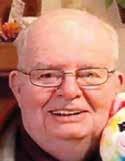
Deacon Welch was married to his high school sweetheart, Carol (Langille) Welch, for almost 70 years. He was born May 25, 1931 to the late Judge John and Marion Welch. He graduated from St. Mary’s school in 1945, Taunton High School in 1949 and UMass Am herst in 1952.
A veteran of the Korean War, he served his country honor ably while in the U.S. Army. He retired from New England Tele phone & Telegraph.
Deacon Welch is survived by children: Daniel of Lakeland, Fla.; Edward of Raynham; and Sarah of Attleboro; seven grand children; and three great grand
children.
He acted as chairperson of the conservation commission in Raynham for 10 years, in strumental in acquiring Borden Colony for the town.
Deacon Welch was a proud resident of Ray nham for 60 years. He was a Sealer of Weights & Measures and a master storyteller.
As an ordained per manent deacon, he was assigned to St. Ann’s Par ish for 19 years, which he greatly loved.
A Mass of Christian Burial was celebrated November 8 at St. Ann’s Church in Raynham. Burial followed at Pleasant Street Cemetery in Raynham.
Donations in lieu of flow ers may be made to St. Ann’s Church, PO Box #247, Raynham Center, Mass., 02768.

† November 11, 2022
Deacon John Welch
Because of unpredictable circum stances, there will most likely not be a November 25 edition of The An chor . It will resume with the Decem ber 9 edition. Thank you for your patience and understanding.














































